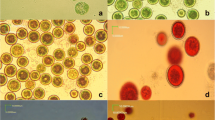Abstract
Calothrix elenkenii was evaluated for accumulation of chlorophyll, β-carotene and phycobiliproteins when grown under light-dark cycles and darkness, in the presence of glucose. Highest values of β-carotene, chlorophyll, proteins and acetylene-reducing activity were recorded when the organism was grown in the presence of glucose under light-dark cycles after 15 d of incubation. The presence of glucose in the medium stimulated pigment production, especially of β-carotene and chlorophyll, which may be due to increased energy-linked assimilation and ATP production. The photoheterotrophic potential ofC. elenkenii can be exploited in value addition for increased and economic production of pigments.
Similar content being viewed by others
Abbreviations
- ARA:
-
acetylene-reducing activity
- APC:
-
allophycocyanin
- L:D:
-
light-dark cycles
- PC:
-
phycocyanin
- PE:
-
phycoerythrin
- TPBS:
-
total phycobiliproteins
References
Adhikary S.P., Pattnaik H.: Growth response ofWestiellopsis prolifica Janet to organic substrates in light and dark.Hydrobiologia 67, 241–247 (1979).
Damerval T., Guglielmi G., Houmard J., Tandeau de Marsac N.: Hormogonium differentiation in the cyanobacteriumCalothrix: a photoregulated developmental process.Plant Cell 3, 191–201 (1991).
Elmorjani K., Herdman M.: Metabolic control of phycocyanin degradation in the cyanobacteriumSynechocystics PCC6803: a glucose effect.J.Gen.Microbiol. 133, 1685–1694 (1987).
Grossman A.R., Lemaux P.G., Conley P.B., Burns B.U., Anderson L.K.: Characterization of phycobiliproteins and linker polypeptide genes inFremyella diplosiphon and their regulated expression during complementary chromatic adaptation.Photosynth.Res. 17, 23–56 (1988).
Hoare D.S., Hoare L.S., Moore R.B.: The photoassimilation of organic compounds by an autotrophic blue-green alga.J.Gen.Microbiol. 49, 351–370 (1967).
Kenyon C.N., Rippka R., Stanier R.Y.: Fatty acid composition and physiological properties of some filamentous blue green algae.Arch.Microbiol. 83, 216–236 (1972).
Kumar A., Tabita F.R., van Baalen C.: High endogenous nitrogenase activity in isolated heterocysts ofAnabaena sp. strain CA after nitrogen starvation.J.Gen.Bacteriol. 155, 493–497 (1983).
Pabby A., Prasanna R., Nayak S., Singh P.K.: Physiological characterization of the cultured and freshly isolated endosymbionts from different species ofAzolla.Plant.Physiol.Biochem. 41, 73–79 (2003).
Pelroy R.A., Ripkka R., Stanier R.Y.: Metabolism of glucose by unicellular blue-green algae.Arch.Microbiol. 87, 303–322 (1972).
Prasanna R., Prasanna B.M., Mohammadi S.A., Singh P.K.: Evaluation ofTolypothrix germplasm for phycobiliprotein content.Folia Microbiol. 48, 59–64 (2003).
Pope D.H.: Heterotrophic potential ofPhormidium and other blue green algae.Can.J.Bot. 52, 2369–2374 (1974).
Raboy B., Padan E., Shilo M.: Heterotrophic capacities ofPlectonema boryanum.Arch.Microbiol. 110, 77–85 (1976).
Ripkka R.: Photoheterotrophy and chemoheterotrophy among unicellular blue green algae.Arch.Microbiol. 87, 303–322 (1972).
Tandeau de Marsac N., Mazel D., Damerval T., Guglielmi G., Capuano V.: Photoregulation of gene expression in the filamentous cyanobacteriumCalothrix sp. 7601: light-harvesting complexes and cell differentiation.Photosynth.Res. 18, 99–132 (1988).
Author information
Authors and Affiliations
Corresponding author
Rights and permissions
About this article
Cite this article
Prasanna, R., Pabby, A. & Singh, P.K. Effect of glucose and light-dark environment on pigmentation profiles in the cyanobacteriumCalothrix elenkenii . Folia Microbiol 49, 26–30 (2004). https://doi.org/10.1007/BF02931641
Received:
Revised:
Issue Date:
DOI: https://doi.org/10.1007/BF02931641




